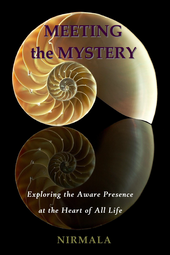 Meeting the Mystery – Nirmala
Meeting the Mystery – Nirmala
Extract – ‘Grace Is All There Is‘.
Note that the whole of Chapter 7 may also be downloaded from Nirmala’s website.

 Meeting the Mystery – Nirmala
Meeting the Mystery – NirmalaExtract – ‘Grace Is All There Is‘.
Note that the whole of Chapter 7 may also be downloaded from Nirmala’s website.
[Here are three questions that I did not come across a seeker raising them. Nor did I find any teacher discussing directly those specific issues and answering them in a logical way. Maybe my literature search is incomplete, I admit. Before I go on to provide my replies to these questions, I will very much appreciate to know the reactions / thoughts of the interested / knowledgeable readers – ramesam.]
The Questions:
A. Bhagavad-Gita related: Continue reading
 Adi Shaṅkara’s vision of advaita is most succinctly expressed in the following pithy statement: Brahma satyam, jagan-mithyā; jīvo-brahmaiva nāpara. (Brahman is Absolute Reality, satyam; the universe is dependent reality, mithyā; the individual, jīva, is none other than Brahman itself).
Adi Shaṅkara’s vision of advaita is most succinctly expressed in the following pithy statement: Brahma satyam, jagan-mithyā; jīvo-brahmaiva nāpara. (Brahman is Absolute Reality, satyam; the universe is dependent reality, mithyā; the individual, jīva, is none other than Brahman itself).
In this statement there is one word that has caused great confusion by being wrongly understood – much of the critical rejection of advaita (as well as the fundamentalist stand on non-duality adopted by some Western advaitins) can be avoided if this word is understood correctly. The word is mithyā.
Traditional advaita vedānta postulates two orders of reality: absolute and relative. The name given to the relative order of reality is mithyā, commonly mis-translated as ‘illusion’. Whereas the neo-advaita teachers accept only one level as valid (i.e. satyam), vedānta accommodates both levels. In the Taittiriya Upaniṣad it talks about two birds on the same tree: one enjoys the fruit of the tree, the other just witnesses. The Īśa Upaniṣad says that one should see everything as the Lord, but if that’s not possible due to attachment to the body then one should live a life performing one’s duty. The very structure of the Vedas themselves reflects this acceptance of a two-fold reality and prescribe (in the karma kāṇḍa section) the best way to live the worldly life and in the vedānta section it reveals the vision of truth. Satyam is the absolute level of reality, mithyā is the ‘as though’ real. Continue reading
Q: 1. If the triple gunas are the matrix of the “reality”, aren’t they immutable and therefore truly real? (I have asked this question a while ago in our personal correspondence but I can’t access my old email and it still bothers me…).
2. What is the ontological status of the course of human history? Is it objective, or just a sort of shared mass illusion that somewhat gets transferred from generation to generation? I am aware of the imprecision of my language but hopefully you will understand my meaning.
A to Q1 (Peter): Guṇas are the subtlest form of manifest matter and, being matter, are thus subject to change. So they are not immutable.
Guṇas in their unmanifest and undifferentiated form are the triple śakti of māyā: jñạna, krīyā and dravya shakti, the undifferentiated and unmanifest powers of knowledge, action and materialisation. When these move into manifestation they get the names sattva, rajas and tamas. Continue reading
My studies of Advaita, the ancient wisdom of Oneness without a second, began with the small precise Monographs that teach its core philosophical essence without making us feel Advaita to be a remote inaccessible concept. The Monographs (called Prakarana Granthas) are usually written in simple Sanskrit words without complex or compound sentences pointing the seeker directly to the Ultimate Reality. Some of them contain excellent metaphors “for easy comprehension” of the abstruse and abstract teachings, some others provide tools for one’s own analysis of one’s experience and yet others provide a step by step guidance on the path of Knowledge holding the hand of the seeker gently and with compassion.
Neem Karoli Baba, my first guru and inspiration on the spiritual path, famously said, “Sub ek,” which means ‘All one.’ I, as perhaps many of us, who heard and contemplated the phrase throughout the years, had my own concept of what that phrase meant.
Many drops, one ocean; many petals, one flower; many sunrays, one sun; many parts, one whole.
It was not until I encountered the teachings of Vedanta that I came to understand what Maharaji in fact most likely meant by ‘sub ek.’
From the perspective of the teachings of Vedanta, sub ek, does not mean many drops one ocean, what it means is the truth of the drops and the truth of the ocean is one alone. One water. The reality of the drops and the reality of the ocean is water.
It means that in reality there are not many separate things that actually exist. There is only one thing that really and truly exists, upon which everything else depends for its apparent existence, and Tat Tvam Asi, You are That.
So what is this That, this one thing, that everything is and you are?
What is the one common denominator in the world of name and form?
Isness, existence. In Sanskrit satyam.
Think about it. Do you ever in your entire experience not exist?
Lord Krishna tells Arjuna in the Bhagavad Gita: “There was never a time I did not exist, neither you, nor these kings. Nor will any of us cease to exist in the future.”
(Chapter 2, verse 12)
Things—objects—which exist and are subject to coming and going in terms of time and space—come and go in existence itself. That existence, which is only one and never ceases, that existence you are.
The recognition of one’s very being as that existence is called ‘jnanam’ or ‘self-knowledge.’ You are That right now, but take your Thatness to be a product of the body/mind, and it isn’t.
Is there ever a time you do not exist? What is your experience? You always are.
“Always I am (sat)
Always I shine (chit)
Never at any time am I not beloved to myself (ananda)
Therefore it is established that I am that One alone,
The meaning of the word satchitananda”
Advaita Makaranda (The Nectar of Nonduality) Verse 2
Committing suicide in the dream. The Sage asks the dreamer if he can drown himself, since he claims to know that it is only a dream.
Ramana Maharshi was one of the greatest philosophers India has seen. One does not need an introduction as much has already been written about him.
He used to direct people to the nature of I, not as the body mind individuality but the very aware-full being. He would relentlessly ask his followers to enquire into the individuality by probing into the innermost recesses with a ‘Who am I’ thought.
This ‘who am I’ should not be taken as a mental, mechanical repetition. Knowledge will not dawn on a person, by forcefully exterminating thoughts and contemplating on ‘Who am I’. Man has become habituated to identifying with the body mind and ‘who am I’ enquiry by an unprepared mind will lead one nowhere.
It can provide a temporary tranquility which can be got even through listening to good music or visiting a hill station. This ‘who am I’ is nothing but claiming the content of our very being as the only truth by negating all that one is not. Once the non self is negated, there is nothing to do. The truth is apprehended as one’s own self. His advice hence was not to get lost in unnecessary thoughts and questionnaires but know oneself, as the truth behind the very ego, the individuality which he thinks he is. One is not the ego, but the very truth behind it.
![]() A mind is the complex of cognitive faculties that enables consciousness, thinking, reasoning, perception, and judgement — a characteristic of human beings, but which also may apply to other life forms. (Wikipedia)
A mind is the complex of cognitive faculties that enables consciousness, thinking, reasoning, perception, and judgement — a characteristic of human beings, but which also may apply to other life forms. (Wikipedia)
(in a human or other conscious being) the element, part, substance, or process that reasons, thinks, feels, wills, perceives, judges, etc.: the processes of the human mind. 2. Psychology. the totality of conscious and unconscious mental processes and activities. 3. intellect or understanding, as distinguished from the faculties of feeling and willing; intelligence. (Dictionary.com)
It is generally agreed that mind is that which enables a being to have subjective awareness and intentionality towards their environment, to perceive and respond to stimuli with some kind of agency, and to have a consciousness, including thinking and feeling. (Wikipedia)
———–
Advaita vedanta is frequently criticized by Western advaitins for its intellectual approach. Many things can be said about this but I would like to clarify here what Advaita Vedanta means by mind.
In the West quite a number of functions are subsumed under this one term ‘mind’. From the point of view of vedanta the above definitions are a bit of a mumbo jumbo. Two flaws in particular need to be pointed out. The first is to do with the use of the word ’consciousness’. Whereas Wikipedia says mind enables consciousness, vedanta states the opposite: consciousness enables mind. The other flaw is that there is no differentiation between all the various functions listed: ‘thinking, reasoning, perception, and judgement ‘.
I would like to take up this latter point here. Continue reading